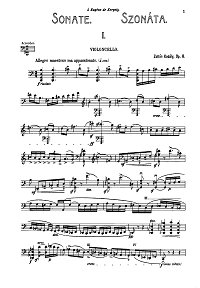Kodaly - Cello sonata solo op. 8
Kodaly - Sonata solo for cello op. 8 . You can download the PDF sheet music Kodaly - Sonata solo for cello op. 8 on this page. The Hungarian composer Zoltán Kodály wrote his Sonata in B minor for solo cello, Op. 8, in 1915. It was first performed in 1918 and published in 1921. It is among the most significant works for solo cello written since Johann Sebastian Bach's Cello Suites. It contains influences of Debussy and Bartók, as well as the inflections and nuances of Hungarian folk music. The piece wavers between B minor and B major, and Kodály adjusted the two lower strings down a semitone (scordatura) to better evoke these tonalities and to extend the instrument's tonal, dynamic and expressive range.
To download PDF, click the "Download PDF" button below the appropriate sheet music image.
To view the first page of Kodaly - Sonata solo for cello op. 8 click the music sheet image.
|
| PDF format sheet music |
|
|
|
Cello part: 21 pages. 5694 K
|
|
 |
|
|
|
| Download PDF (14.99
€) |
|
|
|
The sonata was written in 1915 but its premiere was delayed due to World War I. It was premiered by Jenő Kerpely (1885–1954; sometimes seen as Eugène de Kerpely) in Budapest on 7 May 1918. Kerpely was the cellist of the Waldbauer-Kerpely Quartet, which had premiered the first four string quartets by Bartók. It was published by Universal Edition in Vienna in 1921.
The solo sonata is in three movements:
I. Allegro maestoso ma appassionato
II. Adagio con gran espressione
III. Allegro molto vivace.
Kodaly's Sonata op.8, is the most remarkable and most frequently played chamber work of this Hungarian composer. The simplicity of its three movements contrasts with the extraordinary technical challenges their inventiveness poses for the interpreter and their exploitation of all the possibilities offered by the instrument. Kodaly uses scordatura to lower the bottom two strings of the instrument by a semitone. Also, the cello is transformed in turn into a harp, a cimbalom, a guitar, a violin or a double bass, but also a set of bagpipes and a percussion instrument, and even a whole gypsy band in its verbunkos passages. While the character of the first movement is sometimes reminiscent of his Second String Quartet, the rhapsodic aspects of the second movement point to that Hungarian style which flowered thanks to the composer and his compatriot Bela Bartok. The particularly strenuous third movement gives free rein to gypsy inspiration in lively dance measures interspersed with cadenza-like thematic episodes.
|
|